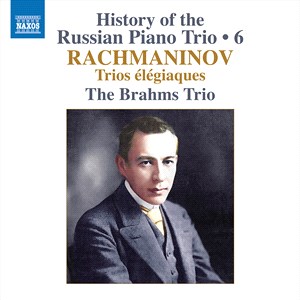

Sergei Rachmaninov (1873-1943): Trio élégiaque No. 1 in G Minor (1892) Sergei Rachmaninov (1873-1943): Trio élégiaque No. 2 in D Minor, Op. 9 (1893, rev. 1907, 1917 (1917 version)
This recording is Volume 6 of an ongoing projected 15 volume series titled History of the Russian Piano Trio, featuring Piano Trios written by Russian composers performed by The Brahms Trio. In a prior review of Volume 4, I had stated: "Ever since its foundation more than 25 years ago, the Brahms Trio has been highly acclaimed for its outstanding artistry, often being called one of Russia's leading chamber music ensembles. Right at the beginning of its career, in 1993, the Brahms Trio won the International Chamber Music Competition in Trapani, Italy, and in 1995 it was awarded the 1st Prize at the Joseph Joachim Chamber Music Competition in Weimar. Russian chamber music is the backbone of the repertoire performed by the Brahms Trio. Recognized as "the leading expert on Russian piano trios" (Music Life Magazine, Russia), the Brahms Trio has performed concert series devoted to Russia's chamber music heritage."
The present volume is focused on a single composer, in this case Sergei Rachmaninov. I've always perceived the single-movement Trio élégiaque No. 1 in G Minor to be a metaphor of life, from birth to death, objectified as a long, arduous and impassioned journey on a train. The hesitant, faltering rhythmic pulse in the strings right at the onset sounds like a train leaving its station and setting off on a long journey into the unknown. The main longing and elegiac theme introduced by the piano serves as the catalyst for this emotional voyage leading to its inexorable destination. As the music fades at the end, you can't help but visualize the train slowing down, and as the dramatic journey comes to an end, it's like witnessing that locomotive being led to the junkyard (graveyard). With a slow and well-paced forward momentum, the members of the Brahms Trio, consciously or not, well capture and project this profound imagery.
Like most of the composers who experienced the turmoils at the onset of the 20th century, Rachmaninov must have been preoccupied with the cogitation of death. In a personal statement by pianist Natalia Rubinstein she writes: "At the heart of the Second Elegiac Trio is a repeated descending chromatic line - the Passus Duriusculus, a Baroque rhetorical figure signifying death. It begins the Trio and runs as a leitmotif throughout the score, leading to a crushing climax. Rachmaninov uses almost all the musical symbols of suffering and death - the motif of Dies Irae, bells, the intonations of a funeral dirge and even the harmonium, originally intended at the score, the sound of which was associated with a memorial liturgy in the listening experience of his contemporaries." The intensity with which she launches into the tormented disquiet of its final movement is almost palpable. In fact, the whole final Allegro risoluto as performed here, from its dramatic peaks of emotion to its lugubrious ending, could be taken as a lesson in passionate musicianship.
If you've yet to partake in this finely curated series of releases, this 6th volume in the cycle is as good a place to start as any. Music from a composer known for his emotive intensity performed by a trio of musicians steeped in its delivery.
Jean-Yves Duperron - May 2025 Trio No. 2 - Opening Movement